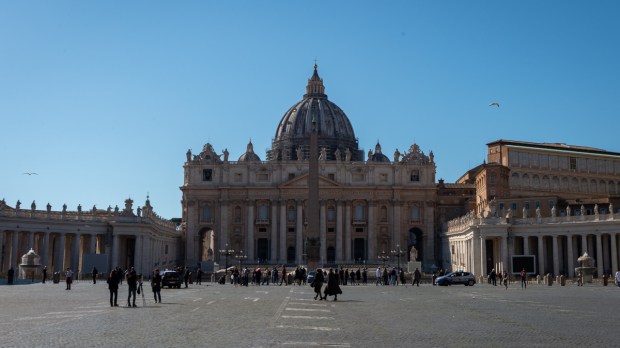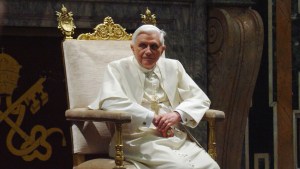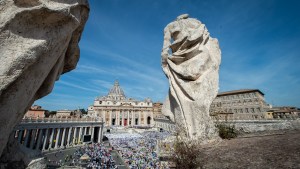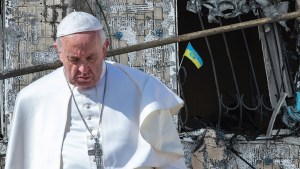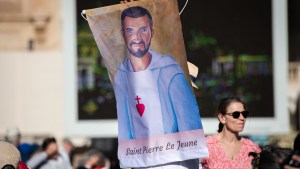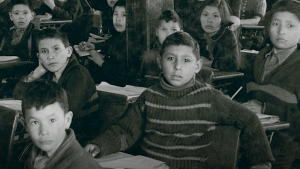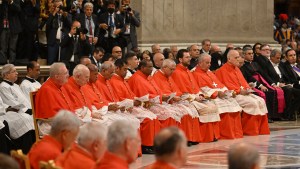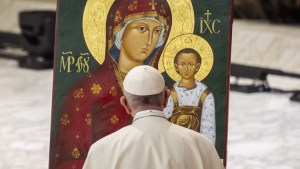The year 2022 was a busy return to post-pandemic life. Here are 12 key moments that marked the year.
January 20: A report implicates Benedict XVI
The beginning of the year at the Vatican was marked by the Pope Emeritus being accused of having mishandled sexual abuse cases committed by four priests under his authority when he was Archbishop of Munich from 1977 to 1982. Benedict XVI refuted these accusations point by point in an 82-page document that can be consulted in the appendices of the report.
Three weeks after the report was published, the Pope Emeritus wrote a letter expressing his “profound shame, [his] deep sorrow” and asked for a “heartfelt request for forgiveness” to the victims of abuse. However, he denied any wrongdoing. He thanked Pope Francis and those close to him for their support. “The grace of being a Christian becomes all the more clear to me. It grants me knowledge, and indeed friendship, with the judge of my life, and thus allows me to pass confidently through the dark door of death,” Pope Benedict XVI wrote.
February 25: Pope Francis visits the Russian Embassy
The day after the Russian invasion of Ukraine, Pope Francis made an unprecedented gesture. On February 25, he went in person to the Russian Embassy to the Holy See to hold a half-hour meeting with the Russian ambassador.
“It was a decision I made on a night of vigil, thinking about Ukraine,” he said in an interview later in the year, expressing his absolute concern that something be done “so that there will not be one more death in Ukraine.”
This unique gesture was the first of a long series of calls for peace. It also illustrates the Pope’s desire for the Holy See to be a possible mediator in the crisis.
March 19: The Vatican publishes the new Constitution of the Curia
Without warning and to everyone’s surprise, Pope Francis decided to publish the new Apostolic Constitution on the Roman Curia on the feast of St. Joseph. The result of 9 years of work, the 54-page text titled Praedicate Evangelium – “Proclaim the Gospel” – replaced the previous constitution, Pastor Bonus, promulgated by John Paul II in 1988. Much of its content was already known, as the Pope had been restructuring parts of the Curia for some years based on the document. For example, some dicasteries had been merged into “super-dicasteries,” such as the Dicastery for Communication in 2015, or the Dicastery for the Laity, Family and Life in 2016 or the Dicastery for Promoting Integral Human Development in 2017. One of Pope Francis’ notable decisions was to make the Pontiff personally the head of the new Dicastery for Evangelization, created in the Constitution, which shows that he wishes to give the entire Curia and the world a missionary impulse.
Giving more space to the laity, Praedicate Evangelium also establishes that all clerics working in the Curia are hired for a term of five years, renewable once. This revolution is supposed to prevent careerism or the creation of power centers in the Vatican. However, in practice, six months after the promulgation of the Constitution the implementation of the five-year term remains unclear.
April 3: From the Grotto of St. Paul in Malta, the Pope’s prayer for migrants
For his first trip of the year abroad, Pope Francis went to the small Mediterranean island of Malta. Following in the footsteps of John Paul II and Benedict XVI who, in 1990 and 2010 respectively, came to visit the cave where the Apostle Paul took refuge after his shipwreck, Pope Francis went to pray for today’s migrants. He also met 200 migrants at the Christian refugee center in Hal-Far, southern Malta. In the wake of his trip to Lampedusa, nine years earlier, he once again warned humanity against the risk of a “shipwreck of civilization” in the face of the migration crisis.
May 3: Pope Francis criticizes Kirill and says he wants to visit Moscow
“Putin does not stop, I want to meet him in Moscow”. This is the title of a shock interview with Pope Francis published by the Italian daily, Corriere della Sera, on May 3. It should be noted the interview doesn’t quote the Pope directly, but offers a journalist’s summary of his words. In the pages of the Italian newspaper, Pope Francis regretted that Vladimir Putin had not yet responded to his proposal to meet. He also questioned the Russian President’s motives for waging such a brutal war, and wondered whether Moscow’s “anger” could be due to NATO’s questionable attitude.
In very unusual remarks, Pope Francis also said he warns Patriarch Kirill, head of the Russian Orthodox Church, against becoming “Putin’s altar boy.” After a historic rapprochement between Moscow and Rome in 2016, when the two men met in Cuba, the war in Ukraine is causing a crisis in relations between the Russian Orthodox Church and the Catholic Church. Two proposals for Francis and Kirill to meet in 2022 – in Jerusalem and Kazakhstan – failed to materialize.
May 5: Pope Francis appears for the first time in a wheelchair
On May 5, Pope Francis appeared for the first time in a wheelchair, as he entered Paul VI Hall for an audience with a group of nuns. Weakened by his right knee – which the Pope later confided has a “small fracture” – the 85-year-old Pontiff was forced to take it easy. He received injections and did kinesiotherapy sessions. However his pain forced him to cancel several events during the year and to use his wheelchair during his trips to Canada (end of July), Kazakhstan (mid-September) and Bahrain (beginning of November). The cancellation of the trip to the DRC and South Sudan at the beginning of the summer fueled rumors of a possible resignation of Pope Francis for health reasons.
May 15: Pope Francis canonizes Charles de Foucauld and 9 other Blesseds
Under a blazing sun, 45,000 faithful from around the world attend the first canonizations celebrated by the Catholic Church since 2019, as the restrictions due to the Covid-19 pandemic forced the Church to pause these celebrations for some time. Pope Francis proclaimed ten new saints, including Charles de Foucauld, a figure who is very dear to him. The life of this former French soldier (1858-1916), beatified in 2005 by Benedict XVI, has often inspired Pope Francis, especially for his encyclical Fratelli tutti. Having initially led a dissolute life, Charles de Foucauld then converted and lived a life of faith and evangelization by example among the Tuaregs in the Algerian Sahara at the beginning of the 20th century. The other saints canonized were: Titus Brandsma, Marie Rivier, Anna Maria Rubatto, Carolina Santocanale, César de Bus, Lazarus Devasahayam Pillai, Justin Russolillo, Maria Domenica Mantovani, and Luigi Maria Palazzolo.
July 25: In Canada, the Pope’s apology to the indigenous people
Despite his knee pain, Pope Francis chose to honor his promise to visit Canada at the end of July, in order to make a “penitential” trip. This visit was eagerly awaited by the country’s indigenous communities, who were hoping for an apology from the Pontiff for the mistreatment inflicted on them in the residential schools run by the Church from 1831 to 1996. One of the Pope’s first stops in the country was to pray at the Ermineskin cemetery, which most likely contains the remains of indigenous children.
During his Canadian journey, he renewed “with shame and unambiguously” his request for forgiveness “for the evil committed by so many Christians against the indigenous peoples.”
August 27: Pope Francis creates 20 new cardinals and convenes his College
The end of August was not an ordinary month in the Vatican, as Pope Francis decided to create 20 new cardinals. Among them, 16 are less than 80 years old and are therefore expected to vote to elect a new Pope in case of a Conclave – one of them, the Ghanaian Cardinal Baawobr, died a few months later in Rome. This consistory reinforced the rise of Asian cardinals, with six new electors, bringing their weight in the college to 16% – up from 9% in 2013. While Europe retains the largest portion of cardinals with 42% of the electors, the representation of this continent has decreased by 10 points since Pope Francis’ election.
Two days after the consistory, the Pope also gathered all his cardinals for two days of meetings behind closed doors to reflect on the implementation of the new Constitution of the Curia. Some Cardinals spoke of a pre-conclave atmosphere.
October 27: Publication of the synthesis of the diocesan phase of the Synod on the future of the Church
One year after the Synod on the future of the Church was launched, the Vatican published the Working Document for the continental stage. The 46-page document, which was drawn up based on 112 summaries – out of 114 Bishops’ Conferences – is intended to serve as a framework for the continental phase. This unprecedented process is supposed to make the Church more missionary, participatory and welcoming, and less centralized and clerical.
The place of women and young people in the Church, the suffering of priests, debates about the liturgy or sensitive situations in the life of the local Churches, remarried divorcees, polygamy, LGBT, abuse, etc. – the text did not evade difficult questions, but also did not yet provide answers. The continental assemblies must take this document into account before submitting their copy so that the Roman phase of the Synod can finally begin in October 2023.
In addition to those meetings in October 2022, the synod will now also take place in October 2024, as part of the same Synod but held in 2 sessions, the Pope announced in October.
November 4: In Bahrain, the Pope salutes the courage of the Grand Imam of al-Azhar
For his fourth foreign trip of the year, Pope Francis went to Bahrain to attend a forum for peace and dialogue between East and West. This journey was also an opportunity to meet again his “brother” al-Tayyeb with whom he had signed in 2019 in Abu Dhabi a historic Declaration advocating for human fraternity. During his stay in the small Sunni kingdom, the Pope also thanked the Grand Imam of al-Azhar for the call to his “Shiite brothers” to dialogue. “You were very courageous today when you talked about dialogue between Muslims,” said Francis, happy to see the fruits of dialogue within the Muslim world.
November 18: the clash between the Curia and the German bishops
The Vatican was the scene of a very lively confrontation between the German bishops and the leaders of the Roman Curia. At issue: the reformist impulses of the Catholic Church in Germany. During a closed meeting, the Prefect of the Dicastery for Bishops, Cardinal Marc Ouellet, put forward the risk of a “schism” raised by certain proposals of the German Synodal Way, initiated in 2019 to respond to the abuse crisis. The Canadian Cardinal’s concerns regard the proposals to abolish mandatory celibacy for priests, ordination of women or proposals to change the Church’s position on sexual morality or on homosexuality.
Unprecedentedly, his statement, as well as that of the Prefect of the Dicastery for the Doctrine of the Faith and that of the President of the German Episcopate, Archbishop Georg Bätzing, have been published by the Vatican.
